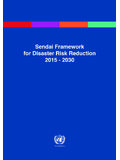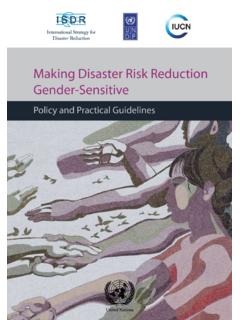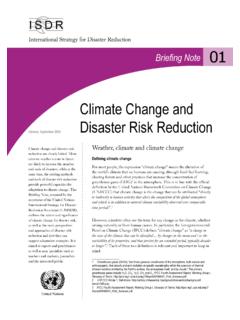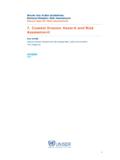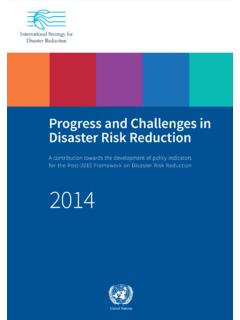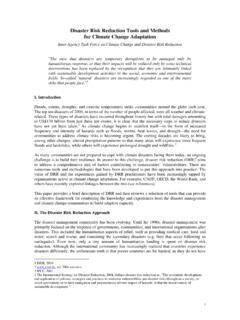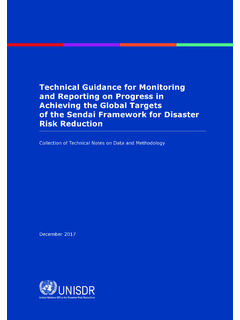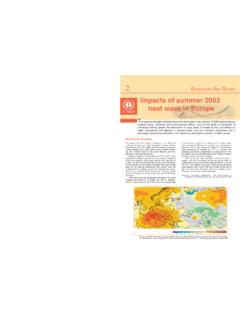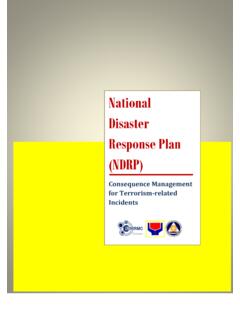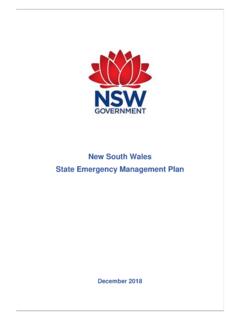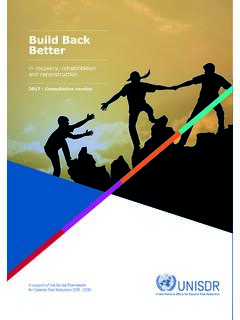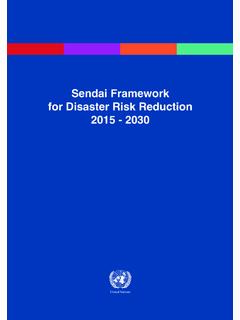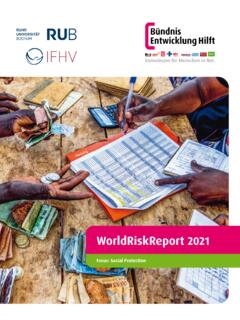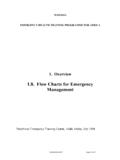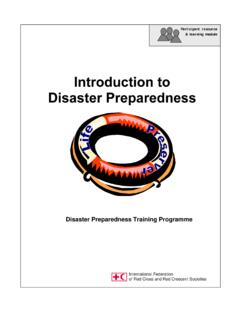Transcription of D ISASTER RISK REDUCTION EFFORTS IN ZIMBABWE
1 D ISASTER RISK REDUCTION EFFORTS IN ZIMBABWE . GOVERNANCE - POLITICAL COMMITMENT AND INSTITUTIONAL ASPECTS. In ZIMBABWE , political will is amply demonstrated by the existence of the legal enabling statute, which creates the conducive environment in which a dedicated disaster management department was spawned. The institutional framework, appropriate policy development and legislative codes all flow from the corporate commitment. It is national Policy for Civil Protection that every citizen of this country should assist where possible to avert or limit the effects of disaster . As provided by the ZIMBABWE Civil Protection Act of 1989, central government initiates hazard REDUCTION measures through relevant sector Ministries with the local administration taking the responsibility for implementing its effectiveness.
2 The Department of Civil Protection is a national organ, which is housed under the Ministry of Local Government, Public Works and national Housing. The Department was established to carry out the overall co-ordination of all relevant disaster management stakeholders. The Department is headed by one Director, one Deputy director, supported by officers and secretaries / typists and a driver. The current system uses the existing Government , private, and NGO organisations whose regular activities contain elements of disaster risk prevention and community development. The Structure of ZIMBABWE Civil Protection System Parliament (Legislative). President (Head of State).
3 Cabinet (Policy formulation). 1 2 3 4 5 6 7 8 9 10. MLG,PW Sister Ministry Departments NGO. &NH Representatives The major priority components of the current Act that enables its implementation include the organisational structure of civil protection in ZIMBABWE from the Local Authority level to the national level, formation of the national , Provincial and District Civil Protection Committees and their subsequent sub committees, the component of planning for emergencies / disasters, the establishment of a Civil Protection disaster Fund, procedures of declaring a State of disaster etc. The country has engaged in a process to review its legislation since 1995 in an effort to strengthen disaster risk REDUCTION .
4 All relevant stakeholders were consulted during the review process and the process has culminated in a Bill for consideration by parliament this year, 2004. 2. The major priorities for the Bill include include among others;. Repeal of the current Civil Protection Act and to be replaced by the Emergency Preparedness and disaster Management Act. Establishment of an Emergency Preparedness and disaster Management Authority whose major functions include developing a risk REDUCTION strategy in order to minimize vulnerability to both natural and man made or technological hazards . Establishment of an integrated early warning system for emergencies and disasters, Promotion of training and research in mattes relating to disasters, Integration of disaster risk REDUCTION into all developmental initiatives Standardised training for emergency services Establishment of a funding mechanism for disaster risk REDUCTION at both the local and national levels.
5 Capacitating of local authorities to manage emergencies and disasters at the local level. In terms of funding, the Department of Civil Protection administers the national Civil Protection Fund which receives money from the Central Government. The fund is applied to the development and promotion of Civil Protection activities through out the country. RISK IDENTIFICATION. Through the Department of Civil Protection the country has in the past conducted a multi sectoral hazard and vulnerability mapping exercise throughout the country. The exercises created the foundation for the development of sectoral emergency preparedness and response plans which are currently being operationalised by the respective sectors / government departments as directed by the national Crisis Committee of ZIMBABWE .
6 Again the findings of the hazard analysis exercises guide the stakeholders in their endeavours in developing Emergency Preparedness and Response (EPR) programmes, which include among others public awareness campaigns and community based early warning outreach programmes. The county carries out regular vulnerability and capacity assessments especially during periods of shocks to collect baseline data for intervention. The methods used include community and household interviews particularly in the rural areas where the most vulnerable people are. Vulnerability assessments have also been carried out in the urban areas with similar objectives of identifying the most vulnerable groups interms of food access and availability, vulnerability to diseases and the impact of HIV/AIDS.
7 ZIMBABWE has made attempts to integrate lessons learnt from past major emergencies and disasters such as droughts, cyclones and major public transportation disasters to examine the extent of damage caused, and to come up with lessons strategies on same. The disaster review / lessons learnt seminars resulted in the improved early warning system of the country's hydro- meteorological disasters such as flooding, cyclones and droughts. The Meteorological Services Department closely monitors the weather 2. 3. and is mandated to regularly give updates and warning information through the laid down channels of communication. The general public is informed of any threatening events through the pre-set channels of communication All disaster Preparedness and Response activities in the country are done through the national Crisis Committee and its sub committees with assistance of technical experts who also constitute a sub committee KNOWLEDGE MANAGEMENT.
8 The Government of ZIMBABWE has not yet developed a database on disaster risk REDUCTION . Information is still being managed at institutional level through sharing reports, minutes, newsletters, and email facilities. However, some UN agencies have developed Web Sites and are working towards the development of databases to enable real-time information sharing with interested partners. The Department has no modern infrastructure that facilitates communication and networking between disaster risk REDUCTION institutions and research centres. However, the recently developed bill has the provision to facilitate communication and networking through the establishment of a disaster management centre where relevant stakeholders would be housed and linked together.
9 Funding for the centre need to be secured. The Department co-ordinates quite a number of public awareness programmes tailored for both the wet and dry seasons. Awareness campaigns on flooding, drowning and lightning hazards are carried out towards and during the wet season whilst campaigns on fire hazards are done in winter. The campaigns are done using a multisectoral approach with Department of Civil Protection having the role of designing and co-ordinating the programmes. Information is disseminated through the press, by pamphlets and road shows. Budgetary constrains limit the use of the electronic media whose effect is far reaching. The Government of ZIMBABWE engages existing institutions for the execution of scientific research work that is in line with disaster risk REDUCTION .
10 For example technical support for scientific research can be obtained from the University of ZIMBABWE and from the Scientific Institute of Research and Development Co- operation (SIRDC) both of which are parastatals. The works they are involved in include studying soil sampled eg in communities that are vulnerable to flooding emergencies and developing sustainable construction materials. They also recommend to policy makers on whether such places are suitable for human settlement or not. Their expertise has also been called for in designing rural building and low cost sewage reticulation plants. RISK MANAGEMENT APPLICATION/ INSTRUMENT. disaster management in ZIMBABWE takes a holistic approach.
